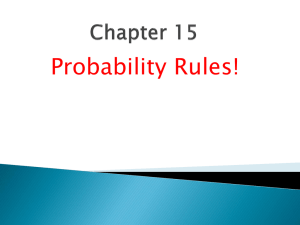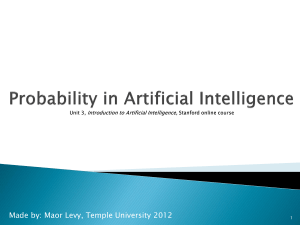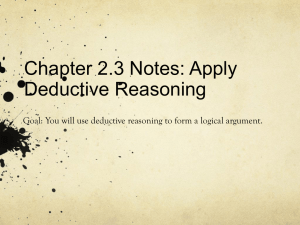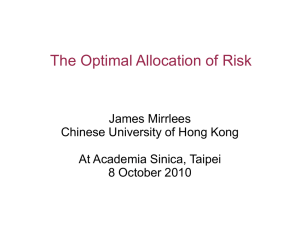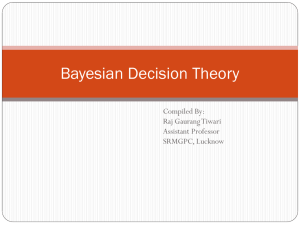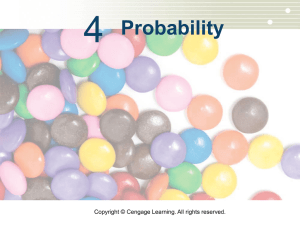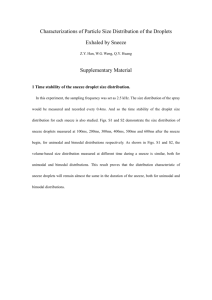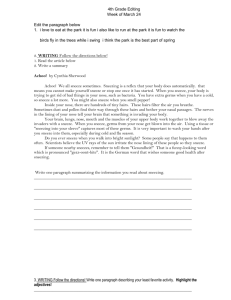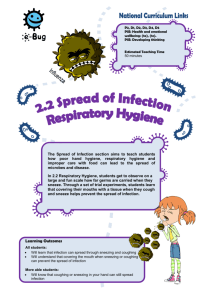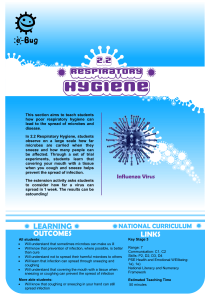Introduction to Artificial Intelligence
advertisement
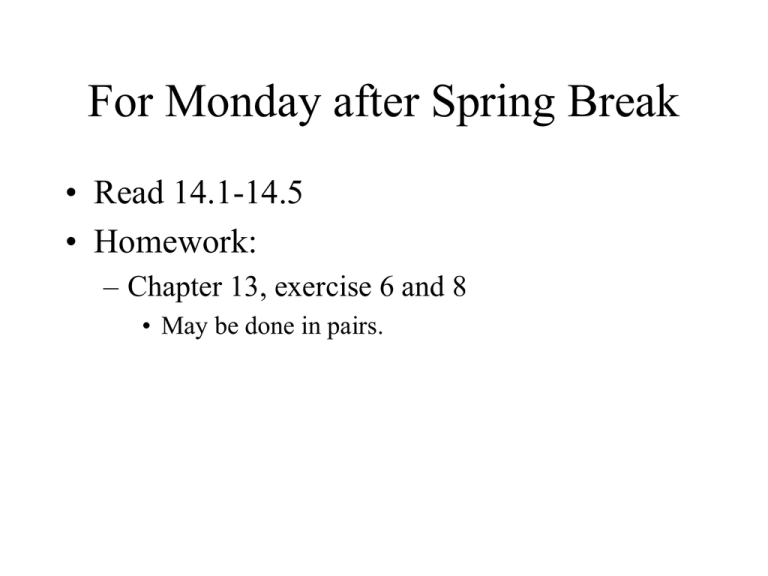
For Monday after Spring Break
• Read 14.1-14.5
• Homework:
– Chapter 13, exercise 6 and 8
• May be done in pairs.
Program 2
• Any questions?
Homework
Water is a liquid between 0 and 100 degrees.
w,s wWater
(Centigrade(0) < Temperature(w,s) < Centigrade(100)) T(w Liquid,s)
Water boils at 100 degrees.
SBoilingPoint(c,bp) x,s xc (t t=Temperature(x,s) t>bp T(x Gas,s))
SBoilingPoint(Water,Centigrade(100))
The water in John’s water bottle is frozen.
bw wWater bWaterBottles Has(John,b,Now) Inside(w,b,Now)
T(w Solid,Now)
Perrier is a kind of water.
Perrier Water
Homework cont.
John has Perrier in his water bottle.
bw wWater bWaterBottles Has(John,b,Now) Inside(w,b,Now)
w Perrier
All liquids have a freezing point.
c RoomTempLiquidSubst(c) t SFreezingPoint(c,t)
A liter of water weighs more than a liter of alcohol.
w,s w Water a Alcohol Volume(w) = Liters(1) Volume(a) = Liters(1)
Mass(w) > Mass(a)
Uncertainty
• Everyday reasoning and decision making is
based on uncertain evidence and inferences.
• Classical logic only allows conclusions to
be strictly true or strictly false
• We need to account for this uncertainty and
the need to weigh and combine conflicting
evidence.
Coping with Uncertainty
• Straightforward application of probability theory
is impractical since the large number of
conditional probabilities required are rarely, if
ever, available.
• Therefore, early expert systems employed fairly
ad hoc methods for reasoning under uncertainty
and for combining evidence.
• Recently, methods more rigorously founded in
probability theory that attempt to decrease the
amount of conditional probabilities required have
flourished.
Probability
• Probabilities are real numbers 01 representing
the a priori likelihood that a proposition is true.
P(Cold) = 0.1
P(¬Cold) = 0.9
• Probabilities can also be assigned to all values
of a random variable (continuous or discrete)
with a specific range of values (domain), e.g.
low, normal, high.
P(temperature=normal)=0.99
P(temperature=98.6) = 0.99
Probability Vectors
• The vector form gives probabilities for all
values of a discrete variable, or its
probability distribution.
P(temperature) = <0.002, 0.99, 0.008>
• This indicates the prior probability, in
which no information is known.
Conditional Probability
• Conditional probability specifies the
probability given that the values of some
other random variables are known.
P(Sneeze | Cold) = 0.8
P(Cold | Sneeze) = 0.6
• The probability of a sneeze given a cold is
80%.
• The probability of a cold given a sneeze is
60%.
Cond. Probability cont.
• Assumes that the given information is all that is
known, so all known information must be
given.
P(Sneeze | Cold Allergy) = 0.95
• Also allows for conditional distributions
P(X |Y) gives 2D array of values for all P(X=xi|Y=yj)
• Defined as
P (A | B) = P (A B)
P(B)
Axioms of Probability Theory
• All probabilities are between 0 and 1.
0 P(A) 1
• Necessarily true propositions have probability 1,
necessarily false have probability 0.
P(true) = 1
P(false) = 0
• The probability of a disjunction is given by
P(A B) = P(A) + P(B) - P(A B)
Joint Probability Distribution
• The joint probability distribution for a set of random
variables X1…Xn gives the probability of every
combination of values (an ndimensional array with vn
values if each variable has v values)
P(X1,...,Xn)
Sneeze
Cold
0.08
¬Cold
0.01
¬Sneeze
0.01
0.9
• The probability of all possible cases (assignments of values
to some subset of variables) can be calculated by summing
the appropriate subset of values from the joint distribution.
• All conditional probabilities can therefore also be
calculated
Bayes Theorem
P(H | e) = P(e | H) P(H)
P(e)
• Follows from definition of conditional
probability:
P (A | B) = P (A B)
P(B)
Other Basic Theorems
• If events A and B are independent then:
P(A B) = P(A)P(B)
• If events A and B are incompatible then:
P(A B) = P(A) + P(B)
Simple Bayesian Reasoning
• If we assume there are n possible disjoint
diagnoses, d1 … dn
P(di | e) = P(e | di) P(di)
P(e)
• P(e) may not be known but the total
probability of all diagnoses must always be
1, so all must sum to 1
• Thus, we can determine the most probable
without knowing P(e).
Efficiency
• This method requires that for each disease
the probability it will cause any possible
combination of symptoms and the number
of possible symptom sets, e, is exponential
in the number of basic symptoms.
• This huge amount of data is usually not
available.
Bayesian Reasoning with Independence
(“Naïve” Bayes)
• If we assume that each piece of evidence (symptom) is
independent given the diagnosis (conditional independence),
then given evidence e as a sequence {e1,e2,…,ed} of
observations, P(e | di) is the product of the probabilities of the
observations given di.
• The conditional probability of each individual symptom for
each possible diagnosis can then be computed from a set of data
or estimated by the expert.
• However, symptoms are usually not independent and frequently
correlate, in which case the assumptions of this simple model
are violated and it is not guaranteed to give reasonable results.
Bayes Independence Example
• Imagine there are diagnoses ALLERGY, COLD,
and WELL and symptoms SNEEZE, COUGH,
and FEVER
Prob
P(d)
P(sneeze|d)
P(cough | d)
Well
0.9
0.1
0.1
Cold
0.05
0.9
0.8
Allergy
0.05
0.9
0.7
P(fever | d)
0.01
0.7
0.4
• If symptoms sneeze & cough & no fever:
P(well | e) = (0.9)(0.1)(0.1)(0.99)/P(e) = 0.0089/P(e)
P(cold | e) = (.05)(0.9)(0.8)(0.3)/P(e) = 0.01/P(e)
P(allergy | e) = (.05)(0.9)(0.7)(0.6)/P(e) = 0.019/P(e)
• Diagnosis: allergy
P(e) = .0089 + .01 + .019 = .0379
P(well | e) = .23
P(cold | e) = .26
P(allergy | e) = .50
Problems with Probabilistic Reasoning
• If no assumptions of independence are made,
then an exponential number of parameters is
needed for sound probabilistic reasoning.
• There is almost never enough data or
patience to reliably estimate so many very
specific parameters.
• If a blanket assumption of conditional
independence is made, efficient probabilistic
reasoning is possible, but such a strong
assumption is rarely warranted.

